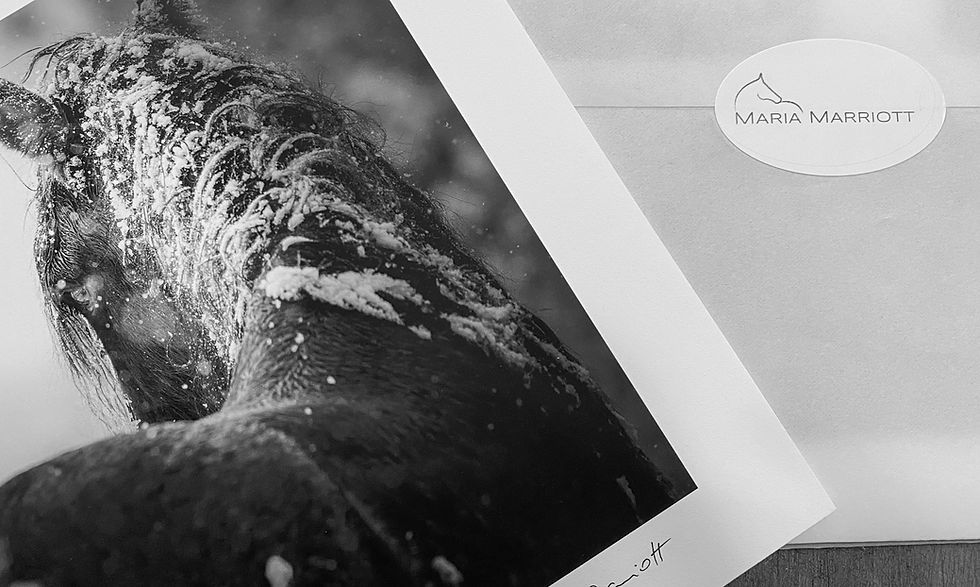Wild Horse Artwork: The Highest Standard
- Maria Marriott

- Sep 29
- 4 min read
Updated: Oct 27

As I’ve grown as a photographer, I have become much more critical about the end product of my wild horse artwork. Many years of focus on how I wanted to present my photographic subjects - the wild horses - has resulted in a recognizable style of simple and unique compositions in which I aim to draw out the emotional content in every scene. Beyond the creative process, there has also been an evolution in how I approach the presentation of my pieces - that is, how the final product is produced and displayed.
My observation throughout the years is that presentation of artwork often seems to be an afterthought for many artists. In my humble opinion, this is a major oversight in the production of some very good artwork I’ve seen - and something I’ve worked hard to address as I’ve become more critical about the end product.
Although perfection is an unattainable standard, it is one I feel we must aim for. The best artwork, the art that causes us to feel and think and converse, needs to have an equally compelling presentation that enhances the work itself.
At art shows and galleries we have the opportunity to talk in-person to collectors and potential collectors about the production of the pieces, but it is very hard to have that opportunity with every single person. With that in mind, I decided to spend some time in a series of articles talking about the various production methods we use (and some that we don’t), and how I think about the main media on which we produce.
Elegance In Simplicity
Museum Grade Paper & Inks, Gallery Framed
The most classic look for producing a photographic print uses museum-grade paper and inks. This is a meticulous process designed to preserve visual fidelity and longevity of each piece over time. It begins with a high-resolution digital image, edited to ensure tonal accuracy and consistency across the final output. The image is then sent to a commercial-grade inkjet printer equipped with a wide-gamut pigment ink system. These printers typically use 8 to 12 color channels, including expanded tones like light cyan, light magenta, and sometimes violet or green, to achieve exceptional detail, smooth gradients, and precise color reproduction.
The inks we use in our studio have been extensively tested by Wilhelm Imaging Research for longevity.
The tests showed that these inks will last for decades, with color prints achieving ratings up to 200 years and monochrome prints achieving ratings up to 400 years under specific display conditions.
The substrate - museum-grade fine art paper - is equally critical. Generally made from 100% cotton rag, this paper is acid-free and lignin-free, ensuring resistance to yellowing and degradation over time. The textured surfaces of these papers enhance the tactile quality of the prints and interact beautifully with pigment inks, which sit atop the paper fibers rather than soaking in, preserving sharpness and vibrancy. Once printed, the artwork is allowed to cure for up to 24 hours to ensure ink stability.

We do most of our fine art printing in house to ensure that every print is carefully reviewed and meets our quality standards. Upon passing inspection, all prints are hand-signed and limited edition prints are notated with the edition number. A designated Certificate of Authenticity accompanies the artwork.
The Back Should Aways Match The Front
High-quality framing is essential for preserving and presenting fine art photography at its highest standard, both aesthetically and archivally. For this reason, we partner with a very limited number of master framers throughout the country to ensure that the quality of the framing matches the quality of the print. After all, framing is an art in itself and it quickly becomes apparent if framing quality is not optimal. Before purchasing any piece, always carefully inspect the sides and the back of the artwork, which should look as clean, “finished”, and professional as the front.
Our standard framing choice - featuring a 1" - 2" black or white gallery-grade wooden frame, a 3" 8-ply museum mat, and low-glare glass or acrylic - ensures that the artwork is not only visually elevated but also protected from environmental stressors. The 8-ply museum mat provides a deep bevel that enhances the visual depth and separates the print from the glazing, preventing ink transfer and moisture buildup. The museum glass or acrylic minimizes reflections and UV exposure, safeguarding the print’s tonal integrity and vibrancy over time. This elegant framing approach enables the image itself to shine and meets conservation standards, making it suitable for exhibition and long-term display in both residential and institutional settings.
I’m still very much a fan of the simple, classic and elegant look, especially for my monochrome images. Much of my own home is decorated with archival fine art prints that have been gallery framed as described above.
I hope this information has been helpful in understanding not only how we tackle the challenge of ensuring that the quality of production and presentation match the quality of the artwork itself in our studio, but also sheds some light on what to look for in selecting quality artwork.
In the next article, we will discuss another production medium, dye sublimation on aluminum, that has become very popular with many of my collectors due to it's clean, contemporary look.





Comments